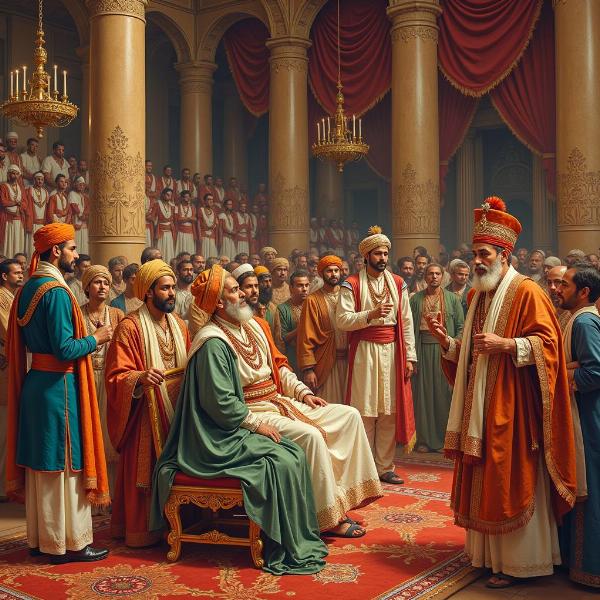Maharaja meaning in Hindi is typically translated as “great king” or “high king”. The term evokes images of opulent palaces, lavish ceremonies, and immense power. Understanding the true meaning and significance of “maharaja” requires delving into the rich tapestry of Indian history, culture, and language. This article explores the various facets of this royal title, its historical context, cultural implications, and linguistic nuances.
Decoding the Term “Maharaja”
The word “maharaja” is a compound word derived from Sanskrit. “Maha” means great or large, while “raja” means king or ruler. Therefore, the literal translation points to a ruler of significant stature. Historically, the title wasn’t simply handed out; it was earned through military prowess, political influence, or sometimes inherited through lineage. The title wasn’t just symbolic; it carried with it real administrative and political power. What distinguishes a maharaja from a raja? While both denote royalty, the prefix “maha” elevates the maharaja to a higher level, suggesting dominion over multiple kingdoms or territories. Think of it as the difference between a king and an emperor.
The Historical Significance of Maharajas
Maharajas played a pivotal role in shaping the political landscape of India. From ancient times to the British Raj, maharajas ruled vast swathes of the Indian subcontinent. Their reigns were marked by both periods of prosperity and conflict. They were patrons of art, architecture, and literature, leaving behind a rich legacy that continues to inspire awe and wonder. The Mughal Empire, for instance, saw powerful maharajas acting as both allies and rivals to the emperor. Their influence extended beyond the political sphere, shaping social norms, religious practices, and economic activities within their kingdoms.
 Maharaja's Durbar
Maharaja's Durbar
Cultural Implications of the Title
The title of maharaja carried immense cultural weight. It symbolized not only political power but also social status and religious authority. Maharajas were often seen as divine representatives or protectors of their people. This reverence shaped the social hierarchy and influenced religious practices within their domains. The opulent lifestyles of maharajas, often depicted in literature and art, further reinforced their elevated status and contributed to the mystique surrounding the title. Even today, the term “maharaja” is used respectfully to address individuals of high standing or achievement, reflecting the enduring cultural significance of the title.
Maharaja in Modern India
While the princely states were integrated into the Republic of India in 1947, the title “maharaja” continues to hold cultural significance. The descendants of former maharajas often maintain their ancestral palaces and properties, playing a role in preserving India’s rich heritage. Some have even transitioned into prominent roles in business, politics, and philanthropy. Although stripped of their former political power, they continue to be regarded with respect and are often seen as custodians of tradition and culture.
Conclusion: The Enduring Legacy of Maharaja
The title “maharaja,” with its deep roots in Sanskrit and Indian history, signifies more than just “great king.” It embodies a complex interplay of political power, social status, and cultural influence. From ancient rulers to modern-day descendants, the legacy of the maharajas continues to shape India’s cultural landscape. Understanding the true maharaja meaning in Hindi requires appreciating this multifaceted history and its enduring impact on Indian society.
FAQ:
- What is the feminine equivalent of Maharaja? Maharani.
- Did all Maharajas have absolute power? Not always, some were vassals to more powerful rulers.
- Are there any Maharajas in India today? While the political power is gone, the title is still used as a courtesy title by descendants of former ruling families.
- What is the difference between Maharaja and Raja? Maharaja implies a higher status and often dominion over multiple territories.
- Where can I learn more about the history of Maharajas? Many historical texts, museums, and palaces offer insights into their lives and reigns.
- Is the term Maharaja still used in common Hindi conversation? Yes, often figuratively to refer to someone powerful or influential.
- What is the cultural significance of the Maharaja title today? It represents a historical connection to India’s rich past and a respect for tradition.
Related Articles:
- r word meaning in hindi
- palchin meaning in hindi
- splendiferous meaning in hindi
- overlord meaning in hindi
Meaning-Hindi.in is your premier destination for professional Hindi translation services. We specialize in various domains, including business, legal, technical, website localization, and academic translations. Our team of expert linguists ensures accurate and culturally sensitive translations, tailored to your specific needs. Whether you require document translation, interpretation, or localization services, Meaning-Hindi.in offers high-quality solutions to bridge the language gap. Contact us today at [email protected] or +91 11-4502-7584 for a personalized quote.